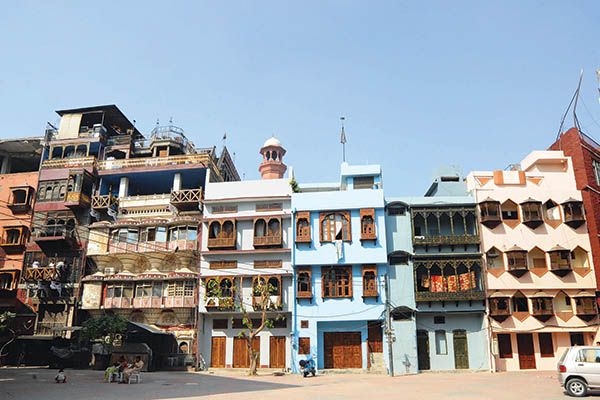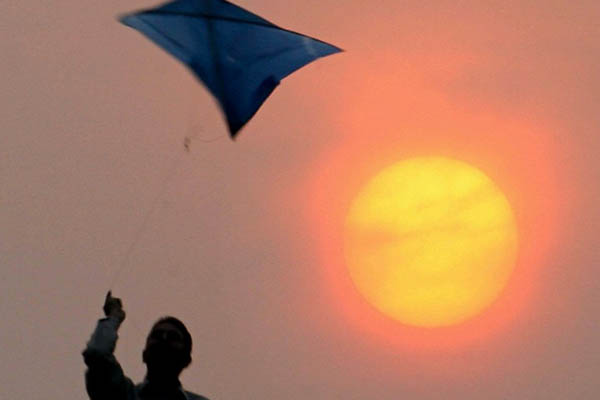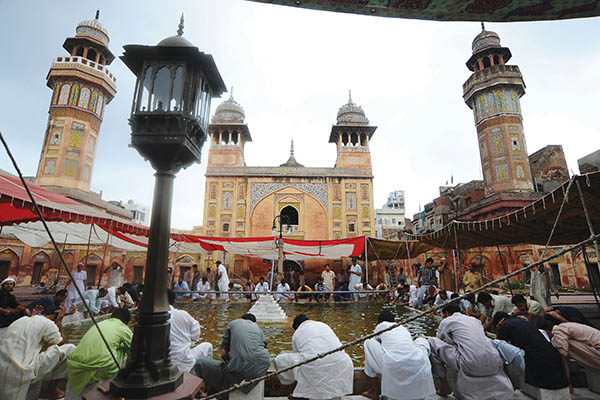
Buildings in the old residential Walled City. Arif Ali—AFP
There is a method to the madness that retains the aura of tradition exemplifying the Punjab capital’s andaroon shehr
British Airways and Virgin Atlantic have both announced direct flights to Lahore in the coming months, perhaps opening the path to a brighter future for travelers who wish to learn more about the city. Lahore, sometimes referred to as Pakistan’s “cultural capital,” is also known as a gateway to the beautiful northern mountain range. It is true that, historically, (inner) cities draw local and international tourism, but it also true that they are home to living communities. To connect the dots between Lahore’s remarkable past and its optimistic future, it might be worthwhile to get acquainted with the history, architecture, lifestyle, and community of old Lahore.
In the heart of modern-day Lahore lies its inner city, or andaroon shehr, one that together with the historical cores of Delhi and Agra, represents the urban cultural center of the highest order of Mughal times, a walled and gated area till the time of British colonial rule, and one that is shrouded in images brimming with color, culture, and an inviting chaos.
A major part of what remains of the medieval city-walls and gates dates to the time of realigning and rebuilding by Emperor Akbar. The additions and alterations by Sikh Maharaja Ranjit Singh, who ruled from 1799 to 1839, form the lesser part; the moat he dug around the Mughal city-walls was filled by the British colonizers, who, after victory in the Second Anglo-Sikh War, annexed Lahore in 1848 and assumed complete control a year later. The connecting bridges and gates and the adjoining portions of the walls were razed. Except for the north side, where the river Ravi used to abut the citadel, the colonizers replaced the moat and the wall with a circular garden.
Despite facing challenges of degeneration, common works of art depict the Walled City with images of kite-flying, traditional cuisines, immaculate dome architecture and an air of hospitality. Interestingly, thus, in the face of debilitating conditions generally prevalent there by popular mindset, the inner city possesses the same raw flavor that it did years ago, albeit with a few infrastructural issues. The popular image is not all hot air. If one were to take a stroll in the narrow streets of andaroon Lahore, one would be awestruck by the high rooftops, each peaking onto the other, the aroma of freshly brewed paye, hareesa and nihari, the many hidden mosques and imam bargahs, and the mohalla-like, warm camaraderie amongst its dwellers.
The Walled City of Lahore is just 2.5 square kilometers. It occupies two mounds in the valley of the river Ravi where the former alluvial plain, south of the old riverbed, is narrower. This muddy area borders the sloping northern corner of a higher plateau. A circular road gives access to the 13 historic entrances of the walled city; only a few of those historic gates still survive or have been restored. It is the oldest and the most densely populated quarter (about 600-700 persons/acre) of the provincial capital. In 1981 its population was reported above 400,000. However, recent estimates place it between 200,000 and 400,000. It is the single largest residential district of Lahore’s impoverished, and according to a rough estimate, more than two thirds of the earning members of families in the Walled City are engaged in commerce and trade, usually as small shopkeepers and businessmen, or as support labor. Less than one fourth of the earning members are government or private employees. The rest are mostly skilled artisans and self-employed professionals. Unskilled workers make up less than one-tenth of the earning population. Most of the residents work either within the Walled City, or within walking distance of it.

Arif Ali—AFP
The dense structure of the Walled City accommodates more than 22,000 buildings. Taking leads from the everyday toponyms in the Walled City, its spatial organization can be described in terms of bazaar, mohallah and guzar. A bazaar refers to an intensely used public route. It is lined with 2-5 storied buildings having fronts ranging from as narrow as 2 meters as that of shophouses to 5-6 meters as that of courtyard houses to over 20 meters as that of havelis (mansions). A mohallah refers to a relatively quieter, densely packed quarter that abuts one or more bazaars. Many mohallahs together make up a guzar.
Traditionally fabricated by a complex mix of trade practices, ethnic affiliations and community obligations, the Walled City has undergone many significant changes in the last few hundred years and currently faces a host of problems that are, to some extent, the result of inadequate maintenance, management and repair of public utilities. To some extent, these changes are related to the intensity of wholesaling, warehousing, and light-industry manufacturing. While commerce is generally located only along the major arteries, industry is also evenly distributed over the residential neighborhoods. The commercial activity ranges from small neighborhood shops to larger local bazaars and some of the regional principal markets. Some examples of the regional markets include the Azam Cloth Market specializing in textiles; the Akbari Mandi in grain, spices and oils; the Kashmiri Bazaar in brass; the Sooha Bazaar in jewelry; the Rang Mahal and Wacho Wali Bazaar in leather goods; and the Shah Aalmi Bazaar in plastics etc. Industry, on the other hand, consists entirely of very small-scale manufacturing enterprises producing a wide range of goods based on paper, metals, leather, fabrics and other industrially produced or natural raw materials, but employing mainly manual labor.
In a complex urban pattern, the main bazaars’ structure a sense of place and direction. Shops of varying depths tend to monopolize the ground floors. The continuous shop fronts, often devoid of display windows, are the overhanging openings from where each shop marches onto immediate space available outside. The curving lines of shops, in which the upper floors are invariably in residential use, are occasionally punctuated with historic religious buildings, a few schools, street lumps, wider street joints (chowks) of many shapes and modest street openings leading to the quarters behind.
Generally, the streets branching off from a main bazaar mark the boundaries of mohallahs in one direction. In the other direction, the entrances to mohallahs, their depths and boundaries between them are both/either mental and/or marked physically by arched gateways or secondary streets.

Muslims perform ablution before offering prayers at the Wazir Khan Mosque. Arif Ali—AFP
A few shop-lined-streets, whether infixed to bazaars or not, intersect within and between adjacent mohallahs. On these streets, it is common to find community religious-centers, small-scale private junior schools, and modest dispensaries. The quieter residential pockets are served by bottlenecks that are very often capped with a house having an opening holed at the ground level to access the narrow residential lane that acts as a link between such residential pockets. The residential lanes across the mohallahs are dotted occasionally with corner shops. Streets between mohallahs are characterized by shop-houses, which wrap mohallahs all around. The inner streets and courts take on character that is more domestic.
Although the urban pattern of the Walled City is historic and the street network corresponds to the old layout, the current spatial demands, coupled with an increase in population density, are squeezing street space to its limits. A general decline in the everyday appreciation for public space points towards weakening community control over them. Almost everywhere in the Walled City, an extension to a building here and another there, at various floor levels, exemplifies the incremental swallowing up of the street volumes in bazaars and mohallahs alike. At some instances, where ample street widths allow, altogether new structures have been added. Similarly, abundant numbers of stalls, structures of which are inherently temporary, occupy street space and add to the congestion. Authorities overlooked the consumption of public space for, as an example, appropriation of squares by bazaar activity, which has exhausted the historic capacity of ceremonial spaces for incubating and strengthening collectivity and heterogeneity among communities.
The Walled City is collapsing, yet at the same time also evolving a highly ambivalent urban condition. As the physical workspace of craftsmen and traders poses a challenge, perhaps the work ethic will stay intact. The Walled City weaves a very organic sense of business and work and is immediately recognizable from afar. Its unique urban structure and post-traditional tendencies are leading to the rise of new cottage industrialization and the communalization of polity. It is currently under immense pressure for change and so for planning intervention. The Walled City Lahore Authority, a dedicated agency caring for its development, is seen as a ray of hope for a repositioning in the overall development mechanism and in the priorities of the public authorities and private investors. One can also hope that in all the ‘advancements’ that the Walled City would undergo in dispelling the adhocracy towards its everyday practicality, the original flavor is restored/retained. Perhaps the mohalla spirit will cling to the streets and remain a constant in the dynamics of public spaces.
Our romantic/nostalgic relationship with our cities has shaped our understanding of them and, very often, we remain uncertain in prioritizing development, resulting in backlash over appearing indifferent. Somewhere in between, authorities can miss chances to truly address grassroot challenges. While there may be a method to the madness, it is the latter that keeps andaroon shehr alive and kicking.
Dr. Bajwa is a Dallas, Texas-based architect and urbanist. He has written and researched extensively on the Walled City of Lahore, including editing/authoringUrban Pakistan: Frames for Imagining and Reading Urbanism.
